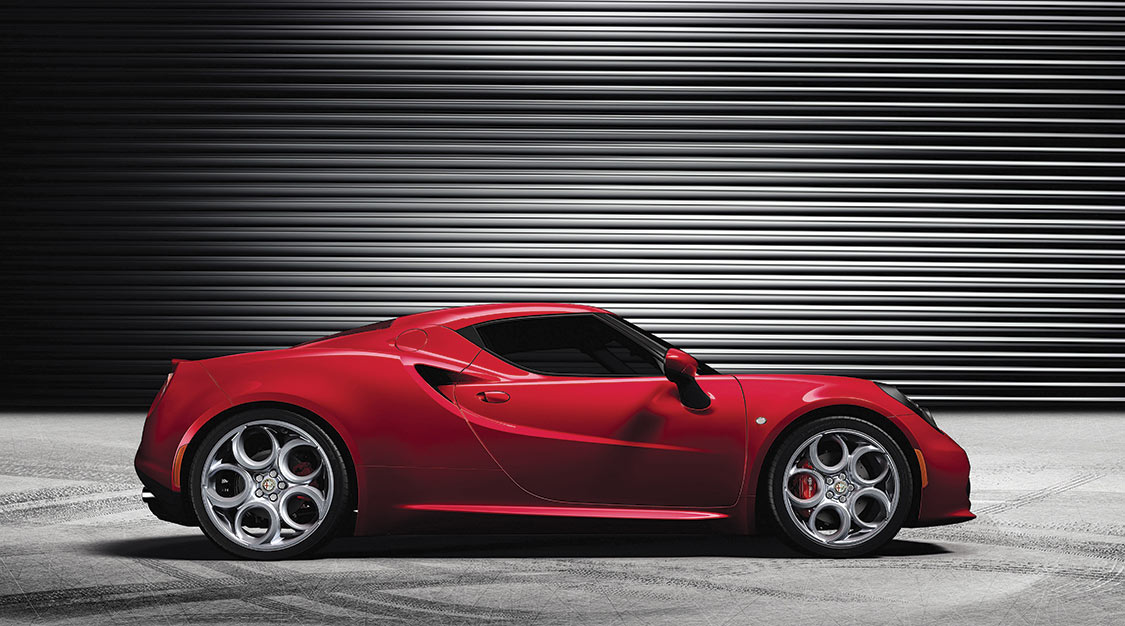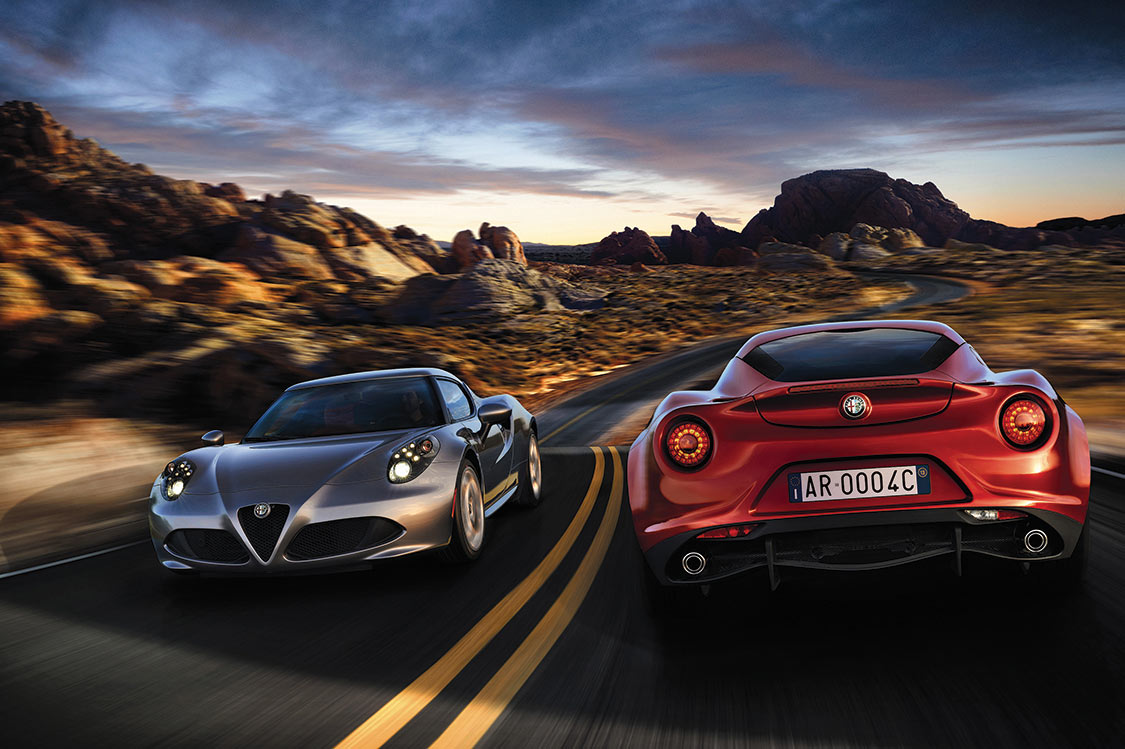 RICH TRUESDELL
.
May 25, 2022
.
All Feature Vehicles
RICH TRUESDELL
.
May 25, 2022
.
All Feature Vehicles

In the first half of 2014, after an absence of almost 20 years, the storied Alfa Romeo brand officially returns to America with the introduction of the carbon-fiber chassis 4C supercar.
In September, automotive journalists from around the world got their first behind-the-wheel taste of Alfa Romeo’s highly anticipated 4C supercar. With just 500 4Cs slated to be imported to North America for 2014, it promises to be one of this year’s “gotta-have” cars.
The 4C will not only spearhead Alfa Romeo’s return to these shores, but it’s expected to launch the revitalized brand in highly competitive markets such as China, now the world’s largest market for new cars. Along with a Giulia, a front-wheel drive, four-door BMW 5 series-size sedan that will be built in a Belvedere, Illinois, and the Dodge Dart, they are expected to introduce Alfa Romeo passion to a new generation that has no idea that an iconic Alfa Romeo roadster was driven by Dustin Hoffman in 1967’s The Graduate.
The consensus of the journalists was uniformly favorable, for many in the extreme. Top Gear’s Richard Hammond (the short one) positively gushed over the car on the pages of the magazine saying, “It’s the best in class, because it’s the only thing in its class. I want one.”
It’s no secret that excessive weight is the enemy in any car with sporting pretensions, be it an American muscle car or a high-strung Italian exotic. With that as part of the 4C’s engineering brief, Alfa Romeo’s design team started with a stiff, strong, but light structure. The 4C’s chassis is a combination of state-of-the-art high-tech materials of extraordinary stiffness and strength—much of the chassis tub is carbon fiber, formerly found in cars costing three to 10 times as much as the 4C—provide the 4C with a monocoque that weighs a scant 143 pounds. To maintain its low weight, the front and rear structures of the chassis and the roof reinforcements are made entirely of aluminum.
Additionally, the car’s bodywork is made of low-density, high-strength composite material. Benefits of using this material include lighter weight (it’s 20% lighter than steel) and resistance to corrosion. Dimensional stability is comparable to steel and better than aluminium.
With less than 2,600 pounds to move around in the U.S.-spec version, the 4C’s turbocharged, direct-injection 1.75L, 1,750cc, 240-hp, four-cylinder all-aluminum engine provides supercar levels of performance. The 1.75L turbo gasoline engine is teamed with the Alfa TCT six-speed, twin dry-clutch transmission. The gears can be changed in sequential mode using the shift paddles located behind the steering wheel. What’s more, to ensure the best performance in accordance with the road conditions and driving style, the Alfa TCT adopts optimized operating logic. It accomplishes this by interacting with the Alfa DNA selector, the braking system, the engine management system and the vehicle stability control system.
For example, in automatic mode, the shifting logic differs according to the Alfa DNA setting. While there’s a slight weight penalty to be paid for by the TCT transmission over a conventional manual gearbox, the benefit is faster shifts that optimize each and every horsepower of the engine’s broad torque range.
A specific evolution of the Alfa DNA selector has been developed for Alfa Romeo 4C, which not only features the three standard settings available on other models in the range—Dynamic, Natural and All Weather—but also a fourth mode, Race, which is designed to enhance the driving experience on a racetrack even further. It only takes a long press of the selector in Dynamic position to activate it: In this mode, the Alfa DNA deactivates the stability control and anti-slip systems, leaving the driver in full, exciting control. Finally, the full-digital instrument panel with TFT display changes configuration (showing only information relevant to the chosen mode) and color in line with the Alfa DNA setting: yellow for Race, red for Dynamic, gray for Natural and blue for All Weather.
The exterior was styled by the Alfa Romeo Style Center, and the 4C immediately brings to mind some of the traditional iconic Alfa Romeo models, which have left a significant mark in the history of the marque. The development of the 4C’s exterior was characterized from the start by the need to enhance the style of the car and the technical characteristics both from a dynamic and aerodynamic point of view. The rear volume, sinuous and enveloping, simultaneously encloses and embraces the beating heart of the car: the mechanics and the engine, visible through the rear window. Alfa Romeo designed the 4C in house. It’s produced in the Maserati plant in Modena, Italy.

The acronym “4C” draws its inspiration from the brand’s glorious past, projecting the values of technology and emotions into the future. Indeed, it refers to Alfa Romeo’s great sporting tradition: the acronyms 8C and 6C in the ’30s and ’40s distinguished cars, both racing and road cars, fitted with the powerful six- and eight-cylinder engines.
If there was a single car from the marque’s glorious past that inspired the 4C’s design, it has to be the 33 Stradale from 1967 to 1969. Like the 4C, it was a mid-engine design and is considered by many to be one of the most beautiful Alfa Romeos of all time.
Entering the cockpit, the first impressions are purposeful, functional and snug. This is epitomized by the lightweight, carbon-fiber central cell, much of which is left in full view to enhance the sense of low weight, technology and uniqueness of the car. The interior has the same sports feel, with highlights provided by the leather/fabric sport seats with parts in Alcantara, as well as the distinctive, numbered carbon badge. In the case of the red livery, the Alfa Romeo 4C Launch Edition has red stitching on the steering wheel trim, handbrake, mats, handles and sport seats. The dashboard and door panels have an “asphalt” treatment to recall the vocation of the Alfa Romeo 4C, conceived to convey maximum driving sensation from the road.

The seats ensure dedicated sports posture, constructed of a mix of carbon fiber and fiberglass, favors the driver’s contact with the road without, however, compromising the comfort required for everyday use of the car. The motorcycle-like, driver-oriented instrument panel is designed to make using functions simple, too. High-impact digital instrumentation and gearshift controls located on the appropriately shaped steering wheel add to driver interaction. The pedal unit and footboards for driver and passenger are all made of aluminum and embellish the lower part under the dashboard, highlighting sports character down to the smallest detail.
The Alfa Romeo 4C has an extremely sophisticated suspension layout—superimposed wishbones at the front, development of MacPherson at the rear—to ensure maximum agility and road holding. This solution, along with the rear-wheel drive and the extraordinary weight to power ratio, ensures Alfa Romeo driving pleasure, enhanced even further by the weight distribution (40% on the front axle and 60% on the rear axle). What’s more, for those who want the maximum in terms of handling, a complete suspension kit will be available with a specific calibration of the shock absorbers and rear anti-roll bar.
The 4C features a high-spec Brembo braking system with four self-ventilating perforated discs. Up front, the 4C is equipped with Brembo four-piston aluminium calipers. In addition, to improve adhesion to the road surface, tires with a different diameter and width are available, depending on how the car is specified. These include combinations of 17-inch front with 18-inch rear wheels or 18-inch wheels up front mated to 19-inch wheels in the rear.
Back in October, just after the 4C’s launch in Italy, a stripped-down version (no air conditioning or radio) of the European Launch Edition 4C was brought to the famed Nürburgring where it turned in a lap time of just 8:04:40 with German journalist and Nordschleife expert behind the wheel. Having lapped the Nürburgring myself back in 2005 in 8:10 flat in a 550-hp Ford GT, I can testify that any time approaching eight minutes is exceptionally rapid, less than 90 seconds behind the most contemporary high-powered, hyper-supercars like the 903-hp McLaren P1 (6:47:00). The time of 8:04:40 for the 4C is the fastest ever recorded at the Nordschleife in a production car with less than 250 hp.
With U.S. base pricing announced at $54,000, the 4C is pitted squarely against established competition like Chevrolet’s all-new C7 Corvette ($51,000) and the Porsche Cayman coupe ($53,550). While all three occupy the same price category, I hardly think the 4C will be cross-shopped against the C7 Corvette, which achieves its performance with the brute force of a highly tuned, naturally aspirated V-8. Its most logical competitor is the Porsche Cayman, which has more horsepower but carries a few more pounds with its conventional chassis.
At press time in mid-November, there is still the question of distribution. While it was initially thought that the 4C would be sold in select Fiat studios (dealerships), there is speculation that for 2014 at least, the limited number of 4C models available to U.S. buyers (500) will be sold by the small number of existing Maserati dealers. No matter which showroom sells the sexy 4C, expect that they will sell out within minutes of the announcement and long waiting lists will follow.
Long term, expect that the 4C will spearhead Alfa Romeo’s resurrection in the United States. It’s the first of what’s expected to be as many as a half dozen Alfa Romeo models by 2017 that should raise sales from the current 101,000 worldwide to 300,000. Among those cars in the pipeline, the previously mention Giulia (in sedan and wagon versions with front- and all-wheel drive), and a crossover, all of which share its platform with the Dodge Dart and Jeep Cherokee. Also on tap is an all-new Alfa Romeo Spider that is being co-developed with Mazda and will share the next Miata’s platform, albeit with an Alfa Romeo engine. And finally, a larger, rear-wheel drive sedan based on Chrysler’s next rear-wheel drive architecture that will underpin the smaller SRT Barracuda will replace the Dodge Challenger, the next Chrysler 300 and Dodge Charger, will follow all due in the 2015-2016 time frame.
While many observers are skeptical, given Fiat-Chrysler CEO Sergio Marchionne’s track record of turning around Chrysler’s fortunes since 2009 and exceeding the most wildly optimistic estimates of his initial four-year turnaround plan, we think that his optimism should not be taken lightly.
Welcome back to America, Alfa Romeo.
Base Sticker Price: $54,000
Displacement: 1,742cc (106.8 ci) turbocharged DOHC inline four-cylinder with direct fuel injection
Bore/Stroke: 3.27 x 3.17 inches
Horsepower: 240 at 6,000 rpm
Torque: 258 at 2,100 rpm
Top Speed: 160 mph
Camshaft: DOHC
Transmission: Six-speed dual dry clutch sequential automatic
Rear axle: Independent
Brakes front: Brembo drilled ventilated discs, 305 x 28mm (4-pot)
Brakes rear: Brembo ventilated drilled discs, 292 x 22mm
Suspension: front: Double wishbone; rear: MacPherson struts
Steering: Unassisted mechanical rack-and-pinion
Wheelbase: 93.7 inches
Chassis: 143 pounds, tube
Weight: 2,600 pounds
Fuel capacity: 10.56 gallons
We use cookies to enhance your browsing experience, serve personalized ads or content, and analyze our traffic. By clicking "Accept All", you consent to our use of cookies. Visit our Cookie Policy for more info.
Notifications
Share Link